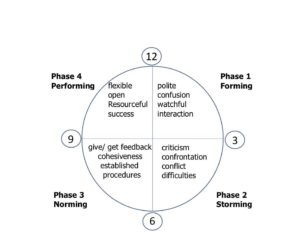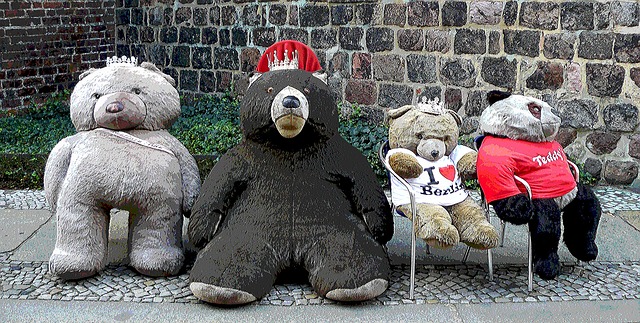The first step on the way to a successful team is team building. How does a team form itself and with what equipment does it equip itself to go to the start in the best possible way?
In this article you will find out what the prerequisites for optimal teambuilding are, how it works and what forms there are.
Möchten Sie regelmäßig über meine aktuellen Artikel und Videos auf dem Laufenden gehalten werden?
Dann freue ich mich, wenn Sie meinen Newsletter abonnieren. Hier klicken zum Newsletter.
How must a successful team be structured?
In our increasingly complex society, we meet the demands of the market most successfully with a wide range of competencies and skills.
If every employee in a company were to work on individual areas of responsibility alone, the complex tasks would no longer be manageable.
The different competences interlock in the team. Goals can be achieved effectively and efficiently together. And innovation in particular is the result of team cooperation.
However, it is well known that it is not enough to gather the best technical experts together and distribute work areas. Successful teamwork results from the employees growing together into a real team.
The optimum group size is usually three to eight people. The closer groups work together on concrete topics, the smaller the unit should be. The more people are involved in something, the greater the tendency to rely on others. The term „social loafing“ has established itself here. In larger teams you can form subgroups, such as tandems or cells.
When forming a team, those responsible also ask themselves the question of team design: Should the members be as homogeneous as possible in personality, cultural background, working style and qualification or as heterogeneous as possible?
Homogeneous teams are more likely to understand each other more quickly and offer less potential for conflict. However, there is a danger that the lower resource diversity will also generate less creativity and innovative spirit. It can quickly develop a rather harmonious way of dealing with each other, but this can also bring social pressure to adapt and suppress „out of the box“ ideas.
Heterogeneous teams have performance advantages, but can be more unstable. The increased coordination effort required to utilize the diversity of resources is a hindrance to the team’s performance. It can become problematic in particular with very different value attitudes in the area of performance. A strong difference in intelligenceis also difficult. The more heterogeneous a team is, the more it needs development and reflection about its own behaviour and the common goal.
How to make a teambuilding successful?
Teams work together successfully if the following is already clarified and defined in the start phase:
The tasks: Who is the customer? What does the customer want? What is the market situation like? What is our goal? What is our vision? What does our company expect from us? What are the time requirements? How do we prioritize? What do we commit ourselves to?
The structure: How are we positioned? Who has what role and responsibilities? Who has what skills, experience and competencies? How do the decision-making processes work? Who leads? Which processes and procedures are defined? What equipment and tools do we use?
The cooperation: How do we deal with each other? What expectations and needs do we have of cooperation? Where and how do we want to and can we cooperate? How do we communicate? Which meetings do we need?
The coexistence: Who are we? What makes us a team? What different personalities are we? In what form do we give ourselves feedback? How do we deal with mistakes? To what extent do we trust each other? How do we deal with conflicts? How do we reconcile our professional life with our private life?
Why are team building measures useful?
For me as a team developer, it seems self-evident that the teamwork does not simply run automatically. Teams first have to consciously follow the path of creating a team by getting to know and finding each other to then perform optimally together.
In my day-to-day work as a consultant, I am quite often surprised at how little thought managers often give to topics such as cooperation, conflict management skills or error culture in their team.
When asked about these topics, most of them nod knowingly. „Yes of course, it’s important, we know“. But when I look at the process of team formation, I often see that teams are put together and tasks distributed „from the top“ and that they start working at full steam. Problems that arise are then often linked to supposedly „difficult employees“ or the challenging market situation.
Most new teams are first of all a group of different individuals who hardly know each other. In today’s increasingly fast-moving markets, teams have little time to slowly get to know each other and to get closer. In order to accelerate the process of teambuilding and to successfully master the necessary topics, team building measures are recommended
What are the goals of a teambuilding intervention?
I use the term teambuilding as a distinction from the natural phase of team building or team finding, which takes place automatically when a team is put together. Teambuilding is understood here as an organized measure in the team building phase.
The goals of a teambuilding intervention are:
- Creation of a positive working environment
- Forming a basis for trusting cooperation and group cohesion
- Emergence of a common, strong spirit and team identity
- Understanding the meaning, situation and goals of the task
- Foundation stone laid for team culture
- Getting to know the personalities, skills, strengths and resources of the team members
- Establishment of internal communication
- Creation of the basis for a feedback, conflict and error culture
How does a team actually develop?
Bruce Tuckman, an American psychologist, developed the well-known phase model for team development, the so-called ’Tuckman’s stages of group development’, in 1965.

Tuckman Team Development by Metakomm
Though it’s been years, I think Bruce Tuckman’s team development modelis a helpful explanatory model. It describes the dynamics and tasks in the development phase of teams. Clockwise, it shows the four phases of a team’s development to maturity.
The Tuckman development model helps me, as a consultant, to analyze the development status of a team when I get to know the team anew.
In teambuilding, it can also serve as an instrument for the team to reflect on where it stands and what path it has to take. I often experience relieved reactions from participants of my team development when they realize with the model that it is quite normal that there is friction and uncertainty in teams in phases and that these, when solved, contribute to form a strong team. They recognize clear learning fields and challenges, which they can then tackle in a targeted manner.
The individual development phases are repeated when a new team member joins an existing team or there is a change in the task.
A team can only be described as ‚well-functioning‘ when the collective performance exceeds the sum of the individual performances.
Like all models, Tuckman’s phase model is a simplistic description of development. How it actually develops, depends on the people involved, the task and the environment. Some teams never reach a stage by performing really well.
The 5 phases of the development path of teams
Tuckman has divided the development path of teams into five phases and has provided them with easily recognizable headings: Forming, Storming, Norming, Performing, Adjourning. More precisely, the following is behind them:
1. Forming
The team members get to know each other in the entry and finding phase. You get to know each other, first goals and rules are defined and the processing of the tasks starts. The relationships between the team members are still unclear.
Therefore, most of them treat each other carefully, politely and wait and see. Also the work order and the goals are usually still unclear. For me, the picture of a handbrake on fits quite well.
From the management, the team needs orientation, clear framework conditions and the example and establishment of respectful and open interaction with each other.
Kick-offs or strategy workshops, in which goals, strategies, work processes and roles are defined, are ideal as supportive teambuilding measures.
They are also the starting point for later regular reviews of the cooperation.
Alternatively, positive, playful group experiences such as outdoor activities can make it easier to get to know each other better and create a communication culture. Managers should make sure that the orientation of these experiences, events and games is not oriented towards competition, which produces winners and losers and causes conflicts.
2. Storming
The first habits have established themselves in the so-called conflict phase, and there may be disagreements about priorities, work ethic and the way of dealing with each other. Goals and tasks are critically questioned. The team members express their opinions, establish closer relationships and defend their interests. Power struggles for leadership, influence on issues and status in the group often occur. According to the conflict culture in the company and in the team, these show up openly or rather covertly. This creates tensions between team members. There is unrest and instability. Communication continues to develop and can become unproductive in a negative case.
It is exciting for me as a consultant when I get to know a team in the storming phase and we discuss the team development phases. I then ask the team members to assess their phase, or analogous to the model, in which phase they are at the moment. Most of them are in the forming phase or already in the following norming phase. Only a few see that they are in the middle of storming. A teambuilding measure that brings the connections to light and allows them to process them productively can be particularly helpful in fading out unwanted and often little-accepted conflicts.
Here, for example, playful tasks are offered in workshops, indoor or outdoor, in which problems have to be analysed and solved together. By reflecting on the process in progress and analysing communication, parallels to the current situation can be quickly identified, emerging conflicts discussed and common rules for dealing with them defined.
Measures that bring unspoken things to light, intensify the exchange and deal with emotions best benefit teams in this phase.
3. Norming
In the regulation and agreement phase, the team members have found their roles, rules and behavioural norms, a sense of togetherness has developed and cooperation is intensified. The relationships are more harmonious. One can better understand the peculiarities of others. The mutual acceptance increases and the team increasingly turns to its task. In a successful case, the team members have learned how to resolve conflicts. Information and thoughts are exchanged openly, cooperation develops.
A basis for the increasing openness and improved communication in the norming phase is the now increased trust among each other.
Further teambuilding measures in this phase are strategy workshops, in which planning, content and process development are increasingly developed at the cognitive level.
4. Performing
If the first three development phases are successful, the team enters the fourth phase, the so-called work and performance phase. The energy that previously flowed into group-dynamic clarification processes can now focus on the work tasks. The team members are open with each other, they cooperate and help each other. The real cooperation has begun. They trust each other and work hand in hand, synergy effects arise. There is an atmosphere of recognition, acceptance and appreciation. The roles can change flexibly between people. Conflicts are addressed and clarified openly and constructively. The identification with the team and its goals is high. Together the team optimizes existing structures.
Once the team has reached this phase, no special team development measures are necessary. It is important that open communication and feedback processes are maintained in order to successfully integrate new requirements and develop further together.
Rewarding incentives such as celebrations, joint meals, visits to the theatre or similar can serve as recognition. Especially when milestones are reached or major tasks are completed, celebrating together increases motivation and promotes loyalty to the employer.
Be aware that the team development process starts all over again when only one new member joins the team. Usually the team goes through this process faster. If the path of teambuilding has been actively taken and regularly communicated, the necessary steps to integrate a new team member are much easier.
5. Adjourning
The dissolution phase is often no longer mentioned in connection with Tuckman’s model. He added his fifth phase only afterwards and in the diagram of his model it also has no more place.
In this phase a team comes when it is disbanded. In addition to documenting and securing the work results, this also involves a review of the shared time, feedback and reflection of what has been learned. An important role is also played by saying goodbye and releasing one’s team-mates and acknowledging the emotions associated with this. Openly expressed thanks and a kind of farewell ceremony can be beneficial.
Why do teambuilding measures fail in practice?
Well intended can unfortunately be far off being well done. Teambuilding offers have been around for many years and their variety is increasing rapidly. Many have already experienced a lot and so an ever wider, sometimes more adventurous to breathtaking range of activities is developing to motivate and impress the participants. Those responsible may then be lured by the offer: „We’ve never done anything like this before, it sounds super exciting“. Of course, you assume that any joint activity will automatically bring teambuilding benefits.
But only because the boss finds a sailing trip on the Baltic Sea or whitewater rafting in the mountains really exciting, this does not apply to all group members. Some participants may cancel their planned team sailing trip at short notice because they are afraid of getting seasick or because they don’t want to come out as a „wimp“. Another one freezes in the climbing park from fear of heights, has to be rescued and feels bad afterwards. This is not a good basis for building trust and positive team dynamics.
Especially teambuilding measures with sporting elements should always be discussed with all participants in advance and nobody should be thrown into the „cold water“. Teambuilding measures should not be designed for entertainment and should be accompanied by a professional coach.
This also applies to internal teambuilding measures. A psychologically trained coach can specifically address each participant within the framework of the measure and thus improve problematic group dynamics. If game ideas are rejected by the individuals, he or she can offer alternatives.
Bottom line:
For a newly formed team to successfully achieve its goals, it must actively and consciously organize itself and coordinate with each other on all important cooperation issues.
An organized team building intervention leads the exciting process of team building into productive paths. At the same time, it accelerates the inevitable phase of friction and enables the roles, structures, relationships and forms of communication of a team to develop productively and positively.
There are different forms and measures that correspond to the respective stage of development of a new team. Professional consultants guide during planning, selection, setting and implementation.
If you would like to learn more about team building, contact me on
Kontakt aufnehmenMöchten Sie regelmäßig über meine aktuellen Artikel und Videos auf dem Laufenden gehalten werden?
Dann freue ich mich, wenn Sie meinen Newsletter abonnieren. Hier klicken zum Newsletter.
If you like this article, share it with your network!



Schreibe einen Kommentar
Du musst angemeldet sein, um einen Kommentar abzugeben.